An Easy Way to Turn Bias Cording Right Side Out
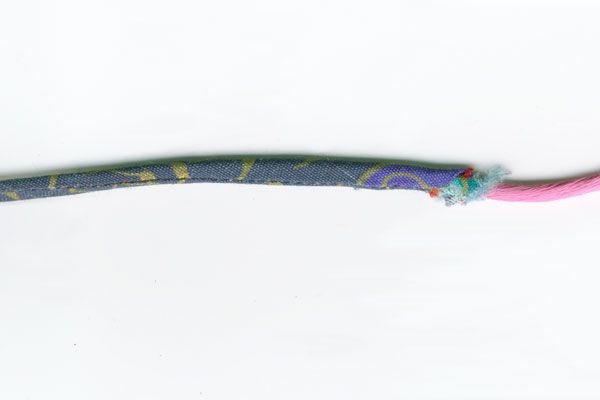
When you cover cording yourself you have all of the possibilities using the same matching fabric offers. You can use your cording for skinny shoulder straps, braid multiple strands for belting, knot buttons, couch embellishments and more. But turning a covered cord to the right side can be a struggle. I have found an easy way to turn the fabric–it depends on the cording you used inside.
1. Cut a bias strip of fabric the finished cording length. Sew strips together as needed to get the length you need.
2. Cut the strip wide enough to wrap the cord, plus ¾ inch for a seam allowance.
3. The cord…and here is the secret…is rayon “rat tail”. The satin surface lets the fabric slide over the cord easily. Rat tail is easily found in the notions departments of fabric and craft stores. It doesn’t have to be a matching color because it won’t show with the completion of the sewn cording.
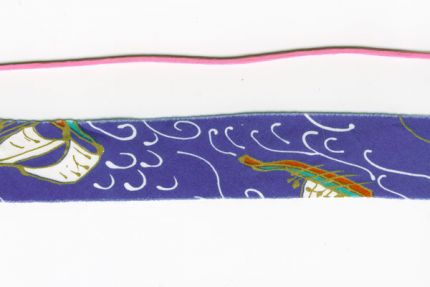
4. Cut the rat tail cord twice the length of the bias fabric. Ex; if the finished bias cording is going to be 30 inches long, start with 60 inches of rat tail.
5. Securely stitch the WRONG SIDE of the bias fabric at the halfway point of the ‘rat tail’ cord as shown below.
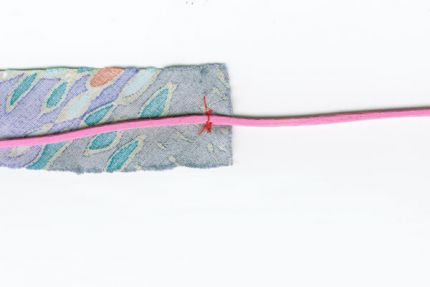
6. Fold the bias strip at the stitching you just finished so the strips right side is against the center of the cord as shown below.
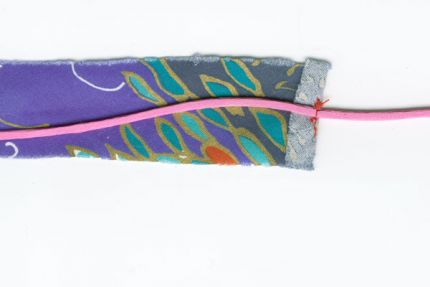
7. Use a cording foot and small stitches to sew through both layers close to the cord, starting at the secured end.
8. To reduce bulk, the seams can be graded.
9. Start at the end that was secured to the cord, using your thumb and index finger, (you might need to moisten them to get the bias fabric started, gently work the bias over the…
Start your 14-day FREE trial to access this story.
Start your FREE trial today and get instant access to this article plus access to all Threads Insider content.
Start Your Free TrialAlready an Insider? Log in



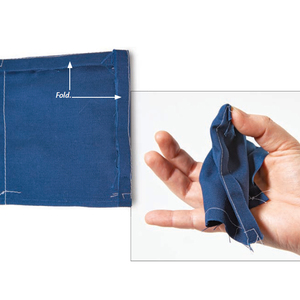
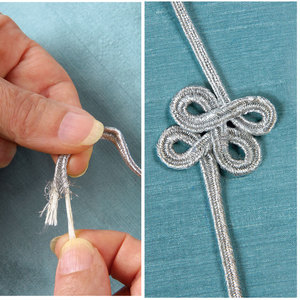
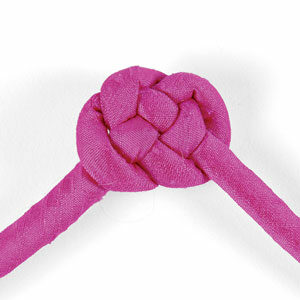
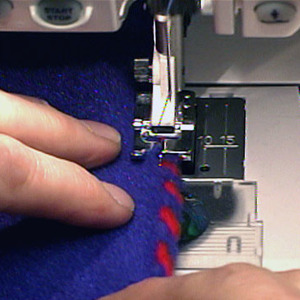
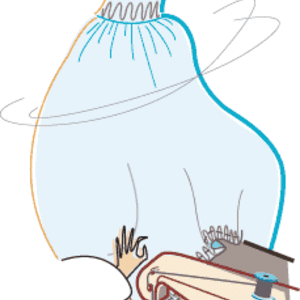


























I LOVE this method. Why does someone else always think of the quickie methods. Thanks to everyone who supplies them to me. EASY when someone else shows you ......yes?
I had some really hard-to-turn silk organza, and I found that wearing a rubber glove (the thin medical kind) made the process of starting the turn much easier.
I've used this technique also but the sewing method I learned is a bit different. Cut your fabric a couple inches longer than you need and the cording about 4" longer. Begin the same way but as you near the far end of the cording with your seam, slowly stitch away from the cord, creating sort of a funnel. Begin turning the fabric from this end. It's easy to turn this funnel to the right side and then gently pull the fabric down the length of the cording to turn it right side out. This method works on non-slippery cording.
thank you for the tip - it looks doable with professional results.
Does anyone know if this cording would also be appropriate for piping on a bathing suit? Is there enough stretch in the cord?
Great ideas. Is my mind going... or does the clematislover solution end up with the cord outside the tube?
This is my favorite method of turning cording. There are no turning tubes in sewing room. Many different fillers work, like thick yarn or several strands of yarn. Latex gloves would help a lot.
Does anyone know if this cording would also be appropriate for piping on a bathing suit? Is there enough stretch in the cord?
- - - - -
Yes, if you leave enough extra length of the rat tail hanging out of the end of the 'tube' to pull in to snug up the fit and adjust in the final fitting. Of course this also depends on the style and materials your swimsuit is made of; many styles and materials do fine w/o the rat tail left inside.
But this produces a simple cord; if I'm understanding correctly, piping in its true sense needs the seam allowance on the outside to be sewn into the suit's seams. Perhaps CCSstudio is going to use this as a surface embellishment?
____________________
Is my mind going... or does the clematislover solution end up with the cord outside the tube?
- - - - -
Yes, no cord is left inside the tube as clematislover describes it, unless you follow Knit Daily's sew-the-center-of-the-rat-tail-to-the-short-edge-of-the-bias-strip-method.
Like clematislover, I too learned this other technique, but a very long time ago—in HS Home Ec class in the late 50s, for the spaghetti straps on our prom dresses that were the style then.
We knotted the cord, folded the bias strip over the cord (knot poking up on the outside) at the top short edge and sewed across the cord just under the knot, then sewed across this short half inch seam at the top edge with the zipper foot. Sew twice as insurance if your cord is thick or stiff as you'll be clipping the knot/cord off and the stitching may leave a gap.
If you were to use this cording to make, for example, surface embellishment like Chinese knots instead of sewing the ends inside of something like our straps, you'd want these end seam stitches to be even and tight.
Turn to come down the long side of the tube, right against the cord and after a few inches, clip off the knot, then begin to ease the end of the tube inside itself (great idea with the medical gloves!)
Continue to pull the cord as you sew and by the time you get to the end the cording is completely right-side out. No turning tubes needed!
I have designed miniature artist teddy bears since 1990 and the limbs of a 2" bear are sometimes only 3/4" long x 3/8" wide"—and furry napped inside as well; the devil's own time to turn right side out after hand stitching right along the edges with 20 sts to the inch.
These are treated in the same way: though these aren't nice straight bias-cut tubes, the same principle applies. I thank heaven for Sister Gregory, O.S.A., who insisted that every stitch be perfect or we rip them all out.....
Excellent article made simple enough to understand. Thank you Threads and Louise Cutting for a great technique.
I lost you between steps 6 and 7. Are you folding the bias in half lengthwise over the cord? Right sides together or wrong sides together? It says stitch through both layers, but it is not obvious WHICH layers you are stitching-is the cord on the outside or the inside?
Please clarify.
I love and use most of the comments listed on the "comments" part of the hints and tips section. Thanks for helping all the sewers with this valuable information.
For step 7
Do you sew along the cord on both sides of it? In which case a zipper foot would work.
Why do you need a cording foot? Or are you sewing over the cord? In a zig zag?
A picture of the stitches would really help please, as I don't understand .
Thankyou
From a puzzled New Zealander.
I'm with bbkmm.... I'm lost about the same things that she is. Could you clarify?
I can not find rat tail. I have a small store in the mountains and even searched my distributors and can't find it. Please tell me where you purchase yours so I can look for it there and at least buy it for myself as I love your method and use piping as border between borders a lot and I hate most I find. I usually end up buying piping in a package and using theirs after removing the fabric as it's the nicest I can find.
One additional trick if you have a lot of rat tail on hand, such as if you use this technique often or use it for necklaces, is to not cut the rat tail off the roll until after you finish. Simply measure out the length your finished cord will be, and attach your inside-out bias tube so that it continues up (toward the roll) from the attachment point. Then, when you turn it right-side out, you can trim the rat-tail just above the attachment, leaving the remainder of the roll ready for further use, without having gradually diminishing lengths of cord to work with. :-)
In an attempt to answer questions asked below:
bbkmm: When you sew the tube, it is wrong-side out, as is usual for making bias tubing. The "wrong" half of the rat-tail is inside the tube, providing a pre-installed pulling handle for when you turn the tube right-side out. When you turn the bias tube right side out, you transfer it from one half of the rat-tail to the other.
seafield: You only sew up one side of the cord; the fabric is folded in half around the cord. If you prefer a zipper foot to a cording foot, I can't think of any reason you couldn't use it, but a cording foot is a natural choice for this.
Mountainquilter: Try a jewelry supply company like Fire Mountain Gems if you are having problems finding rat-tail as a sewing supply. Rat-tail is used as an inexpensive cord for pendants, and FMG gives great volume discounts. When I find it as a sewing supply, it is usually just called covered cord or satin cord- there doesn't seem to be a standard name for it. It is cotton or cotton-like filler cord covered in a satin-like outer layer, very smooth and soft with a small turning radius. You can distinguish it from regular covered cord by the softness- most covered cord is very firm.
Do you require qualified Twitter fans just for your business? Good, you may acquire them at this website: [url=http://buytargetedfollowers.com]Buy Twitter Followers[/url]
I was OK looking at the pictures but at the last (most important part) it was all text. Pictures of the last would be most helpful.
Has anyone else had this problem? As i watch these clips from Louise, the screen keeps jumping and it is most annoying.